Child and Adolescent Care: Appendicitis, Growth, and Family Care
VerifiedAdded on 2020/03/01
|7
|1940
|51
Report
AI Summary
This report delves into the multifaceted realm of child and adolescent care, using a case study of a young patient named Anna who was diagnosed with appendicitis. It begins with an introduction to the condition, including its pathophysiology, symptoms, and diagnosis. The report then explores growth and developmental theories, particularly focusing on Freud's psychosexual development stages and how they relate to Anna's age and health status. The crucial role of family-related care is emphasized, highlighting the importance of parental consent, sibling support, and cultural influences during hospitalization. Furthermore, the report examines the effects of hospitalization on children, addressing their fears and concerns, and underscores the significance of effective communication between children, their families, and healthcare providers. The conclusion reiterates the need for comprehensive support from both parents and nurses to ensure optimal care for children and adolescents, particularly during times of illness and hospitalization.
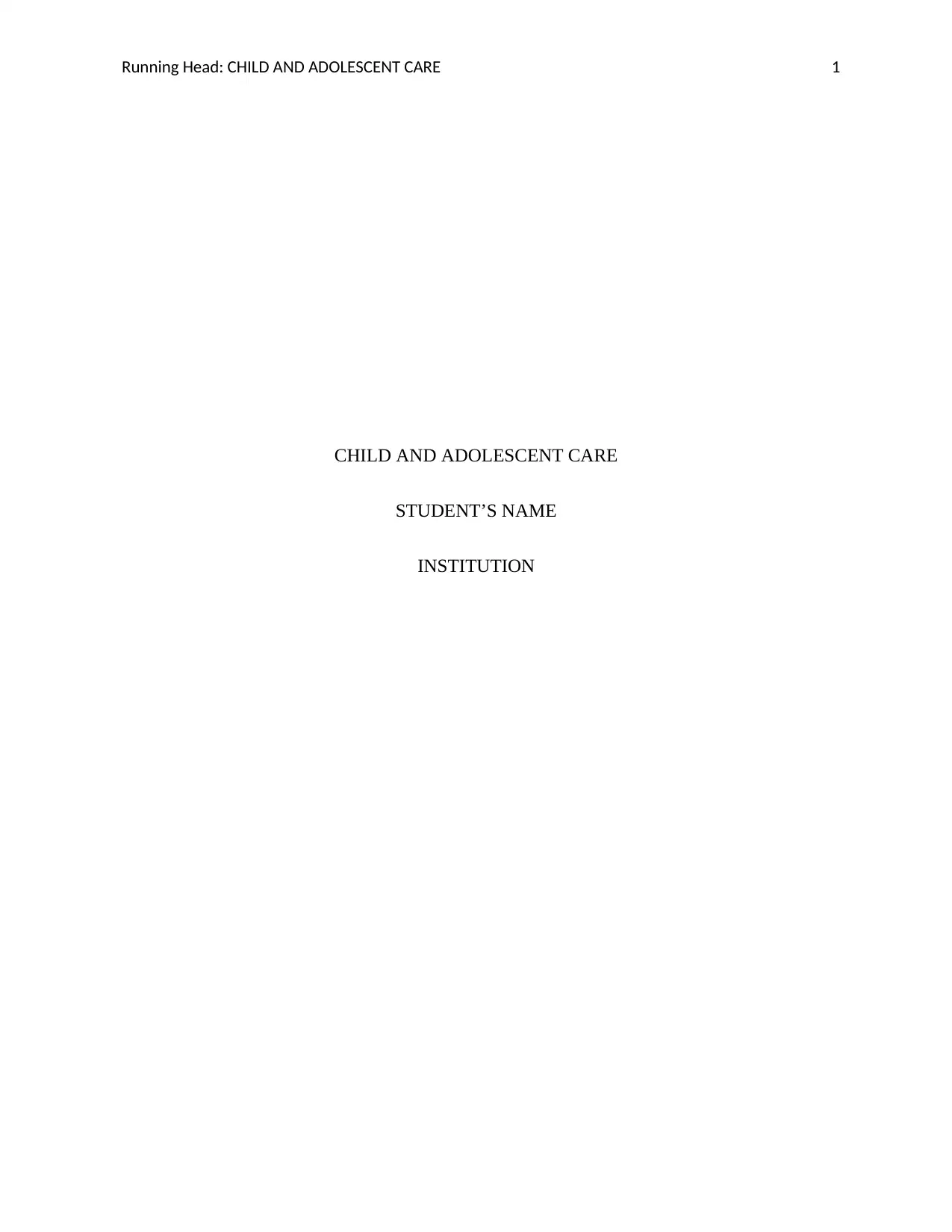
Running Head: CHILD AND ADOLESCENT CARE 1
CHILD AND ADOLESCENT CARE
STUDENT’S NAME
INSTITUTION
CHILD AND ADOLESCENT CARE
STUDENT’S NAME
INSTITUTION
Paraphrase This Document
Need a fresh take? Get an instant paraphrase of this document with our AI Paraphraser
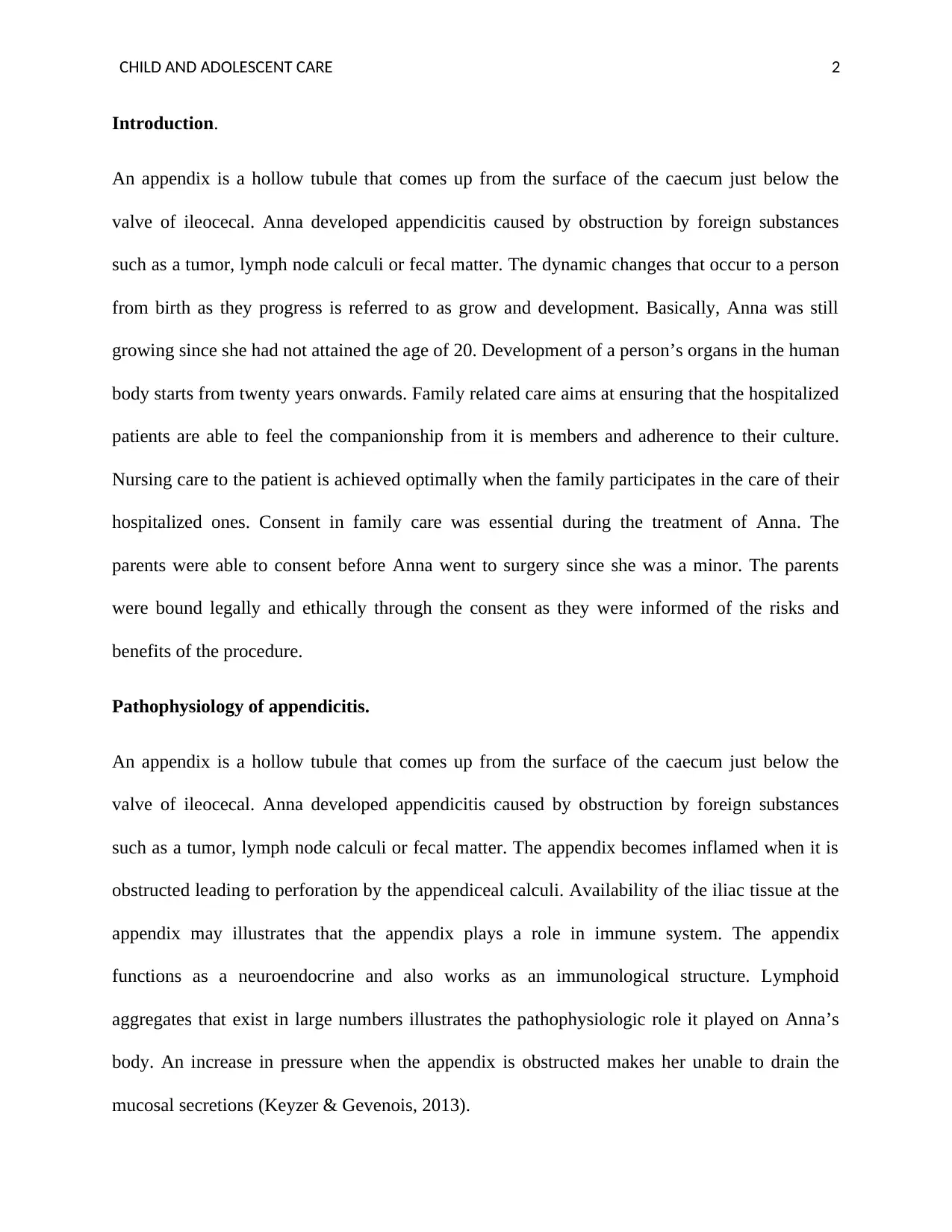
CHILD AND ADOLESCENT CARE 2
Introduction.
An appendix is a hollow tubule that comes up from the surface of the caecum just below the
valve of ileocecal. Anna developed appendicitis caused by obstruction by foreign substances
such as a tumor, lymph node calculi or fecal matter. The dynamic changes that occur to a person
from birth as they progress is referred to as grow and development. Basically, Anna was still
growing since she had not attained the age of 20. Development of a person’s organs in the human
body starts from twenty years onwards. Family related care aims at ensuring that the hospitalized
patients are able to feel the companionship from it is members and adherence to their culture.
Nursing care to the patient is achieved optimally when the family participates in the care of their
hospitalized ones. Consent in family care was essential during the treatment of Anna. The
parents were able to consent before Anna went to surgery since she was a minor. The parents
were bound legally and ethically through the consent as they were informed of the risks and
benefits of the procedure.
Pathophysiology of appendicitis.
An appendix is a hollow tubule that comes up from the surface of the caecum just below the
valve of ileocecal. Anna developed appendicitis caused by obstruction by foreign substances
such as a tumor, lymph node calculi or fecal matter. The appendix becomes inflamed when it is
obstructed leading to perforation by the appendiceal calculi. Availability of the iliac tissue at the
appendix may illustrates that the appendix plays a role in immune system. The appendix
functions as a neuroendocrine and also works as an immunological structure. Lymphoid
aggregates that exist in large numbers illustrates the pathophysiologic role it played on Anna’s
body. An increase in pressure when the appendix is obstructed makes her unable to drain the
mucosal secretions (Keyzer & Gevenois, 2013).
Introduction.
An appendix is a hollow tubule that comes up from the surface of the caecum just below the
valve of ileocecal. Anna developed appendicitis caused by obstruction by foreign substances
such as a tumor, lymph node calculi or fecal matter. The dynamic changes that occur to a person
from birth as they progress is referred to as grow and development. Basically, Anna was still
growing since she had not attained the age of 20. Development of a person’s organs in the human
body starts from twenty years onwards. Family related care aims at ensuring that the hospitalized
patients are able to feel the companionship from it is members and adherence to their culture.
Nursing care to the patient is achieved optimally when the family participates in the care of their
hospitalized ones. Consent in family care was essential during the treatment of Anna. The
parents were able to consent before Anna went to surgery since she was a minor. The parents
were bound legally and ethically through the consent as they were informed of the risks and
benefits of the procedure.
Pathophysiology of appendicitis.
An appendix is a hollow tubule that comes up from the surface of the caecum just below the
valve of ileocecal. Anna developed appendicitis caused by obstruction by foreign substances
such as a tumor, lymph node calculi or fecal matter. The appendix becomes inflamed when it is
obstructed leading to perforation by the appendiceal calculi. Availability of the iliac tissue at the
appendix may illustrates that the appendix plays a role in immune system. The appendix
functions as a neuroendocrine and also works as an immunological structure. Lymphoid
aggregates that exist in large numbers illustrates the pathophysiologic role it played on Anna’s
body. An increase in pressure when the appendix is obstructed makes her unable to drain the
mucosal secretions (Keyzer & Gevenois, 2013).
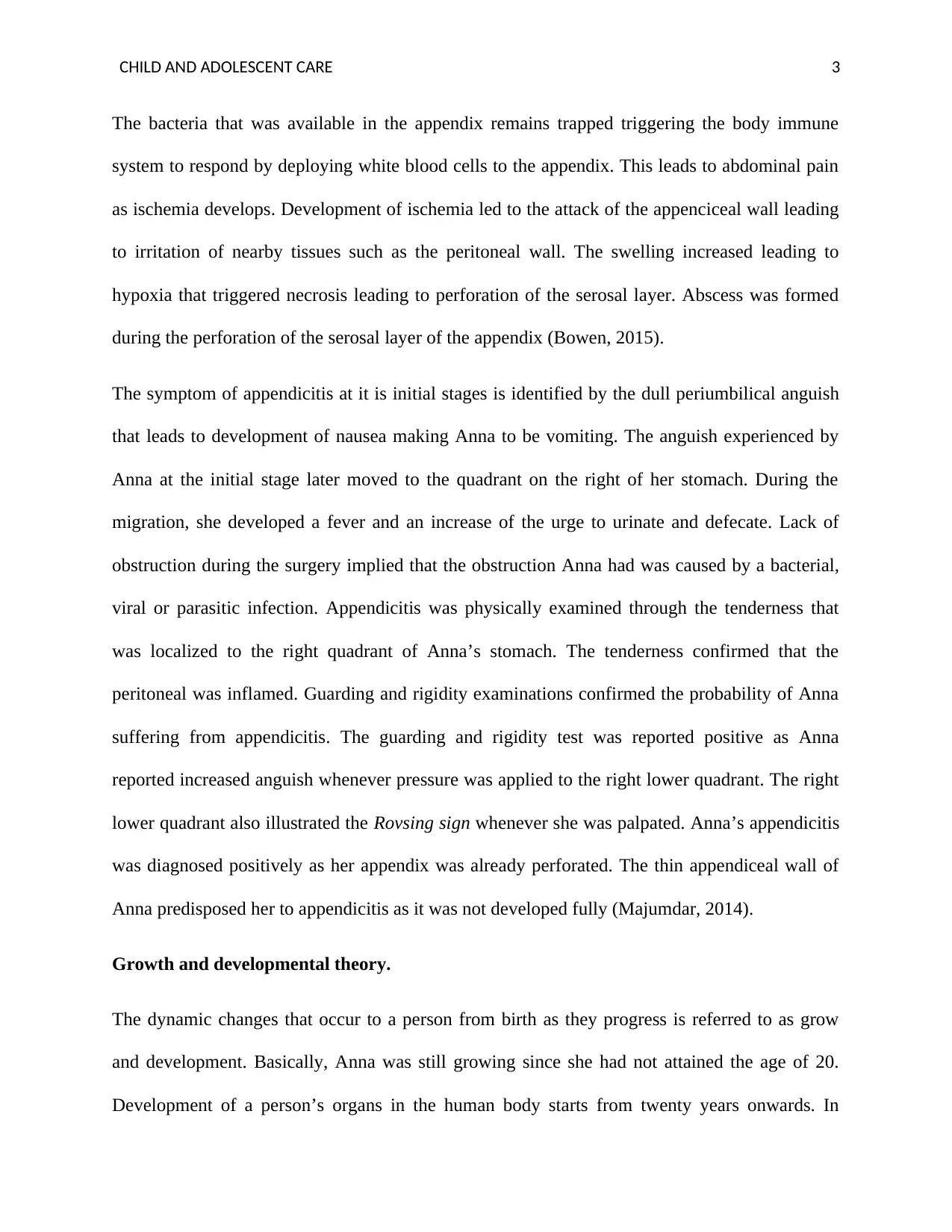
CHILD AND ADOLESCENT CARE 3
The bacteria that was available in the appendix remains trapped triggering the body immune
system to respond by deploying white blood cells to the appendix. This leads to abdominal pain
as ischemia develops. Development of ischemia led to the attack of the appenciceal wall leading
to irritation of nearby tissues such as the peritoneal wall. The swelling increased leading to
hypoxia that triggered necrosis leading to perforation of the serosal layer. Abscess was formed
during the perforation of the serosal layer of the appendix (Bowen, 2015).
The symptom of appendicitis at it is initial stages is identified by the dull periumbilical anguish
that leads to development of nausea making Anna to be vomiting. The anguish experienced by
Anna at the initial stage later moved to the quadrant on the right of her stomach. During the
migration, she developed a fever and an increase of the urge to urinate and defecate. Lack of
obstruction during the surgery implied that the obstruction Anna had was caused by a bacterial,
viral or parasitic infection. Appendicitis was physically examined through the tenderness that
was localized to the right quadrant of Anna’s stomach. The tenderness confirmed that the
peritoneal was inflamed. Guarding and rigidity examinations confirmed the probability of Anna
suffering from appendicitis. The guarding and rigidity test was reported positive as Anna
reported increased anguish whenever pressure was applied to the right lower quadrant. The right
lower quadrant also illustrated the Rovsing sign whenever she was palpated. Anna’s appendicitis
was diagnosed positively as her appendix was already perforated. The thin appendiceal wall of
Anna predisposed her to appendicitis as it was not developed fully (Majumdar, 2014).
Growth and developmental theory.
The dynamic changes that occur to a person from birth as they progress is referred to as grow
and development. Basically, Anna was still growing since she had not attained the age of 20.
Development of a person’s organs in the human body starts from twenty years onwards. In
The bacteria that was available in the appendix remains trapped triggering the body immune
system to respond by deploying white blood cells to the appendix. This leads to abdominal pain
as ischemia develops. Development of ischemia led to the attack of the appenciceal wall leading
to irritation of nearby tissues such as the peritoneal wall. The swelling increased leading to
hypoxia that triggered necrosis leading to perforation of the serosal layer. Abscess was formed
during the perforation of the serosal layer of the appendix (Bowen, 2015).
The symptom of appendicitis at it is initial stages is identified by the dull periumbilical anguish
that leads to development of nausea making Anna to be vomiting. The anguish experienced by
Anna at the initial stage later moved to the quadrant on the right of her stomach. During the
migration, she developed a fever and an increase of the urge to urinate and defecate. Lack of
obstruction during the surgery implied that the obstruction Anna had was caused by a bacterial,
viral or parasitic infection. Appendicitis was physically examined through the tenderness that
was localized to the right quadrant of Anna’s stomach. The tenderness confirmed that the
peritoneal was inflamed. Guarding and rigidity examinations confirmed the probability of Anna
suffering from appendicitis. The guarding and rigidity test was reported positive as Anna
reported increased anguish whenever pressure was applied to the right lower quadrant. The right
lower quadrant also illustrated the Rovsing sign whenever she was palpated. Anna’s appendicitis
was diagnosed positively as her appendix was already perforated. The thin appendiceal wall of
Anna predisposed her to appendicitis as it was not developed fully (Majumdar, 2014).
Growth and developmental theory.
The dynamic changes that occur to a person from birth as they progress is referred to as grow
and development. Basically, Anna was still growing since she had not attained the age of 20.
Development of a person’s organs in the human body starts from twenty years onwards. In
⊘ This is a preview!⊘
Do you want full access?
Subscribe today to unlock all pages.

Trusted by 1+ million students worldwide
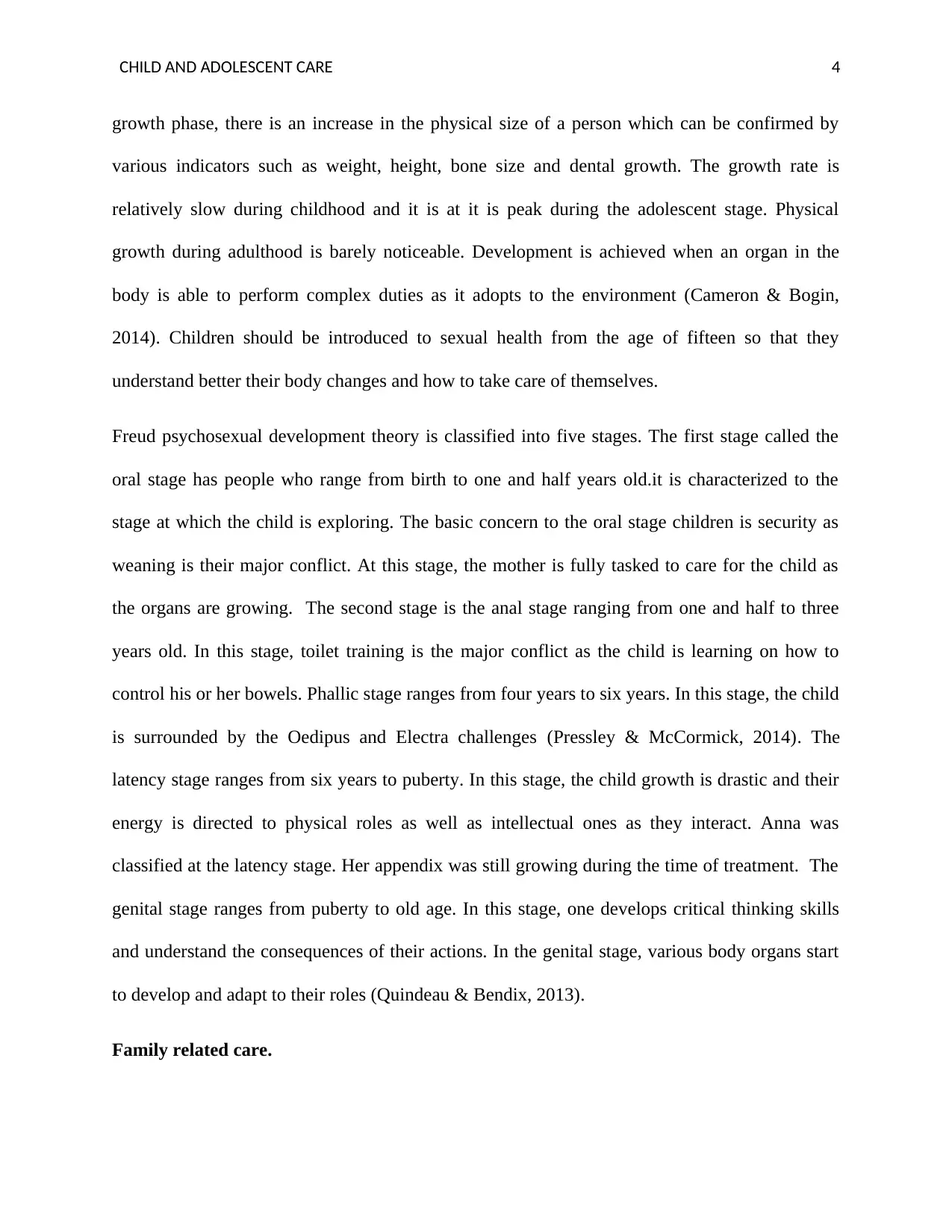
CHILD AND ADOLESCENT CARE 4
growth phase, there is an increase in the physical size of a person which can be confirmed by
various indicators such as weight, height, bone size and dental growth. The growth rate is
relatively slow during childhood and it is at it is peak during the adolescent stage. Physical
growth during adulthood is barely noticeable. Development is achieved when an organ in the
body is able to perform complex duties as it adopts to the environment (Cameron & Bogin,
2014). Children should be introduced to sexual health from the age of fifteen so that they
understand better their body changes and how to take care of themselves.
Freud psychosexual development theory is classified into five stages. The first stage called the
oral stage has people who range from birth to one and half years old.it is characterized to the
stage at which the child is exploring. The basic concern to the oral stage children is security as
weaning is their major conflict. At this stage, the mother is fully tasked to care for the child as
the organs are growing. The second stage is the anal stage ranging from one and half to three
years old. In this stage, toilet training is the major conflict as the child is learning on how to
control his or her bowels. Phallic stage ranges from four years to six years. In this stage, the child
is surrounded by the Oedipus and Electra challenges (Pressley & McCormick, 2014). The
latency stage ranges from six years to puberty. In this stage, the child growth is drastic and their
energy is directed to physical roles as well as intellectual ones as they interact. Anna was
classified at the latency stage. Her appendix was still growing during the time of treatment. The
genital stage ranges from puberty to old age. In this stage, one develops critical thinking skills
and understand the consequences of their actions. In the genital stage, various body organs start
to develop and adapt to their roles (Quindeau & Bendix, 2013).
Family related care.
growth phase, there is an increase in the physical size of a person which can be confirmed by
various indicators such as weight, height, bone size and dental growth. The growth rate is
relatively slow during childhood and it is at it is peak during the adolescent stage. Physical
growth during adulthood is barely noticeable. Development is achieved when an organ in the
body is able to perform complex duties as it adopts to the environment (Cameron & Bogin,
2014). Children should be introduced to sexual health from the age of fifteen so that they
understand better their body changes and how to take care of themselves.
Freud psychosexual development theory is classified into five stages. The first stage called the
oral stage has people who range from birth to one and half years old.it is characterized to the
stage at which the child is exploring. The basic concern to the oral stage children is security as
weaning is their major conflict. At this stage, the mother is fully tasked to care for the child as
the organs are growing. The second stage is the anal stage ranging from one and half to three
years old. In this stage, toilet training is the major conflict as the child is learning on how to
control his or her bowels. Phallic stage ranges from four years to six years. In this stage, the child
is surrounded by the Oedipus and Electra challenges (Pressley & McCormick, 2014). The
latency stage ranges from six years to puberty. In this stage, the child growth is drastic and their
energy is directed to physical roles as well as intellectual ones as they interact. Anna was
classified at the latency stage. Her appendix was still growing during the time of treatment. The
genital stage ranges from puberty to old age. In this stage, one develops critical thinking skills
and understand the consequences of their actions. In the genital stage, various body organs start
to develop and adapt to their roles (Quindeau & Bendix, 2013).
Family related care.
Paraphrase This Document
Need a fresh take? Get an instant paraphrase of this document with our AI Paraphraser
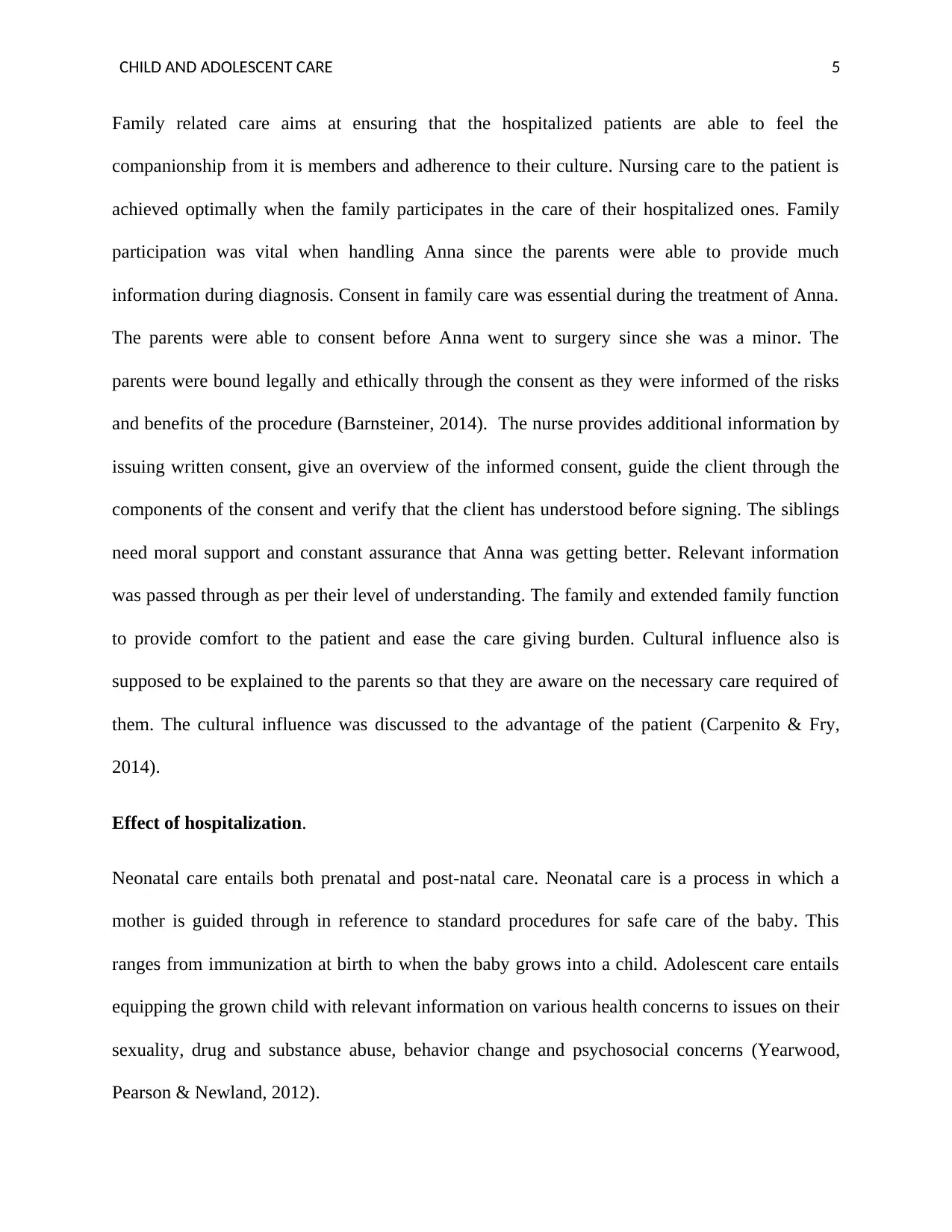
CHILD AND ADOLESCENT CARE 5
Family related care aims at ensuring that the hospitalized patients are able to feel the
companionship from it is members and adherence to their culture. Nursing care to the patient is
achieved optimally when the family participates in the care of their hospitalized ones. Family
participation was vital when handling Anna since the parents were able to provide much
information during diagnosis. Consent in family care was essential during the treatment of Anna.
The parents were able to consent before Anna went to surgery since she was a minor. The
parents were bound legally and ethically through the consent as they were informed of the risks
and benefits of the procedure (Barnsteiner, 2014). The nurse provides additional information by
issuing written consent, give an overview of the informed consent, guide the client through the
components of the consent and verify that the client has understood before signing. The siblings
need moral support and constant assurance that Anna was getting better. Relevant information
was passed through as per their level of understanding. The family and extended family function
to provide comfort to the patient and ease the care giving burden. Cultural influence also is
supposed to be explained to the parents so that they are aware on the necessary care required of
them. The cultural influence was discussed to the advantage of the patient (Carpenito & Fry,
2014).
Effect of hospitalization.
Neonatal care entails both prenatal and post-natal care. Neonatal care is a process in which a
mother is guided through in reference to standard procedures for safe care of the baby. This
ranges from immunization at birth to when the baby grows into a child. Adolescent care entails
equipping the grown child with relevant information on various health concerns to issues on their
sexuality, drug and substance abuse, behavior change and psychosocial concerns (Yearwood,
Pearson & Newland, 2012).
Family related care aims at ensuring that the hospitalized patients are able to feel the
companionship from it is members and adherence to their culture. Nursing care to the patient is
achieved optimally when the family participates in the care of their hospitalized ones. Family
participation was vital when handling Anna since the parents were able to provide much
information during diagnosis. Consent in family care was essential during the treatment of Anna.
The parents were able to consent before Anna went to surgery since she was a minor. The
parents were bound legally and ethically through the consent as they were informed of the risks
and benefits of the procedure (Barnsteiner, 2014). The nurse provides additional information by
issuing written consent, give an overview of the informed consent, guide the client through the
components of the consent and verify that the client has understood before signing. The siblings
need moral support and constant assurance that Anna was getting better. Relevant information
was passed through as per their level of understanding. The family and extended family function
to provide comfort to the patient and ease the care giving burden. Cultural influence also is
supposed to be explained to the parents so that they are aware on the necessary care required of
them. The cultural influence was discussed to the advantage of the patient (Carpenito & Fry,
2014).
Effect of hospitalization.
Neonatal care entails both prenatal and post-natal care. Neonatal care is a process in which a
mother is guided through in reference to standard procedures for safe care of the baby. This
ranges from immunization at birth to when the baby grows into a child. Adolescent care entails
equipping the grown child with relevant information on various health concerns to issues on their
sexuality, drug and substance abuse, behavior change and psychosocial concerns (Yearwood,
Pearson & Newland, 2012).
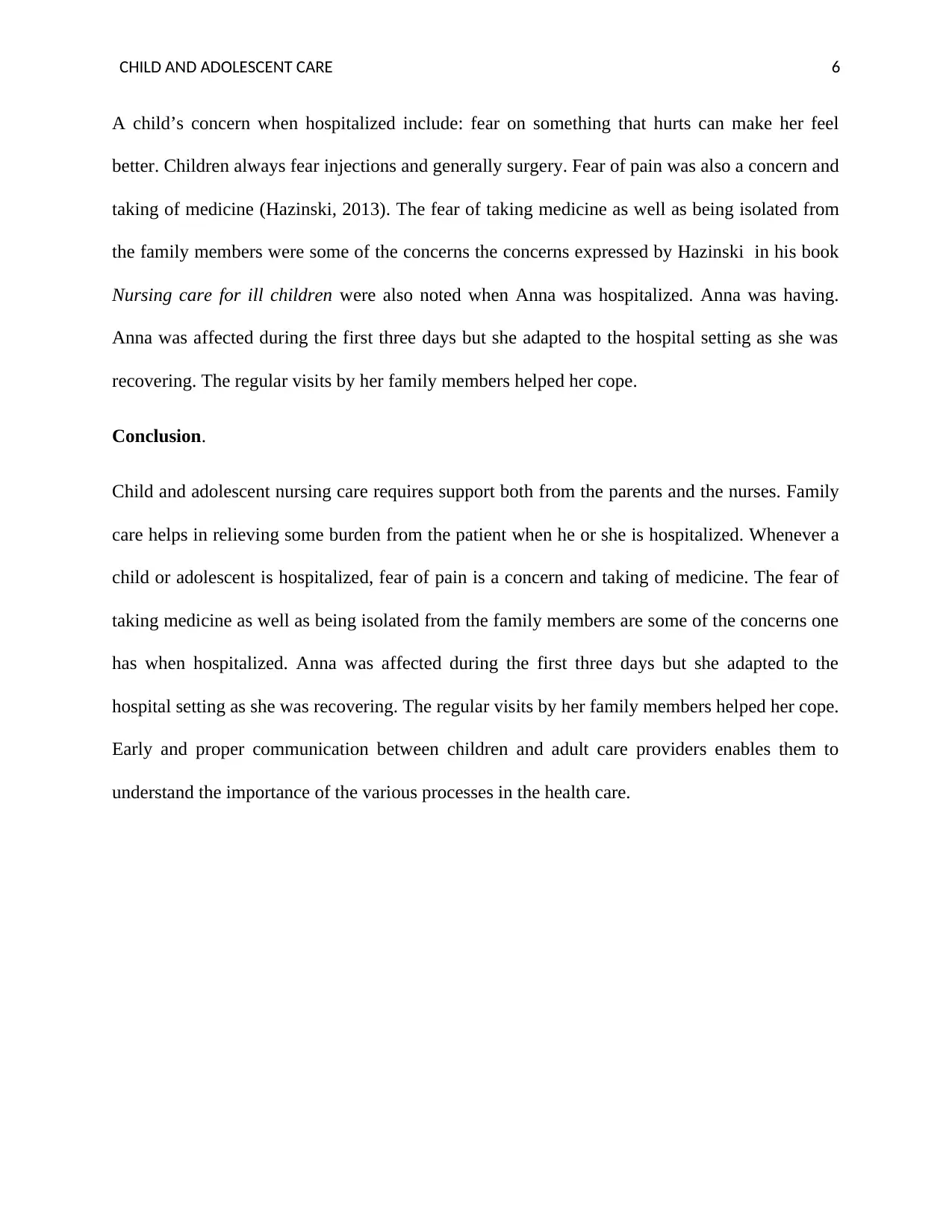
CHILD AND ADOLESCENT CARE 6
A child’s concern when hospitalized include: fear on something that hurts can make her feel
better. Children always fear injections and generally surgery. Fear of pain was also a concern and
taking of medicine (Hazinski, 2013). The fear of taking medicine as well as being isolated from
the family members were some of the concerns the concerns expressed by Hazinski in his book
Nursing care for ill children were also noted when Anna was hospitalized. Anna was having.
Anna was affected during the first three days but she adapted to the hospital setting as she was
recovering. The regular visits by her family members helped her cope.
Conclusion.
Child and adolescent nursing care requires support both from the parents and the nurses. Family
care helps in relieving some burden from the patient when he or she is hospitalized. Whenever a
child or adolescent is hospitalized, fear of pain is a concern and taking of medicine. The fear of
taking medicine as well as being isolated from the family members are some of the concerns one
has when hospitalized. Anna was affected during the first three days but she adapted to the
hospital setting as she was recovering. The regular visits by her family members helped her cope.
Early and proper communication between children and adult care providers enables them to
understand the importance of the various processes in the health care.
A child’s concern when hospitalized include: fear on something that hurts can make her feel
better. Children always fear injections and generally surgery. Fear of pain was also a concern and
taking of medicine (Hazinski, 2013). The fear of taking medicine as well as being isolated from
the family members were some of the concerns the concerns expressed by Hazinski in his book
Nursing care for ill children were also noted when Anna was hospitalized. Anna was having.
Anna was affected during the first three days but she adapted to the hospital setting as she was
recovering. The regular visits by her family members helped her cope.
Conclusion.
Child and adolescent nursing care requires support both from the parents and the nurses. Family
care helps in relieving some burden from the patient when he or she is hospitalized. Whenever a
child or adolescent is hospitalized, fear of pain is a concern and taking of medicine. The fear of
taking medicine as well as being isolated from the family members are some of the concerns one
has when hospitalized. Anna was affected during the first three days but she adapted to the
hospital setting as she was recovering. The regular visits by her family members helped her cope.
Early and proper communication between children and adult care providers enables them to
understand the importance of the various processes in the health care.
⊘ This is a preview!⊘
Do you want full access?
Subscribe today to unlock all pages.

Trusted by 1+ million students worldwide
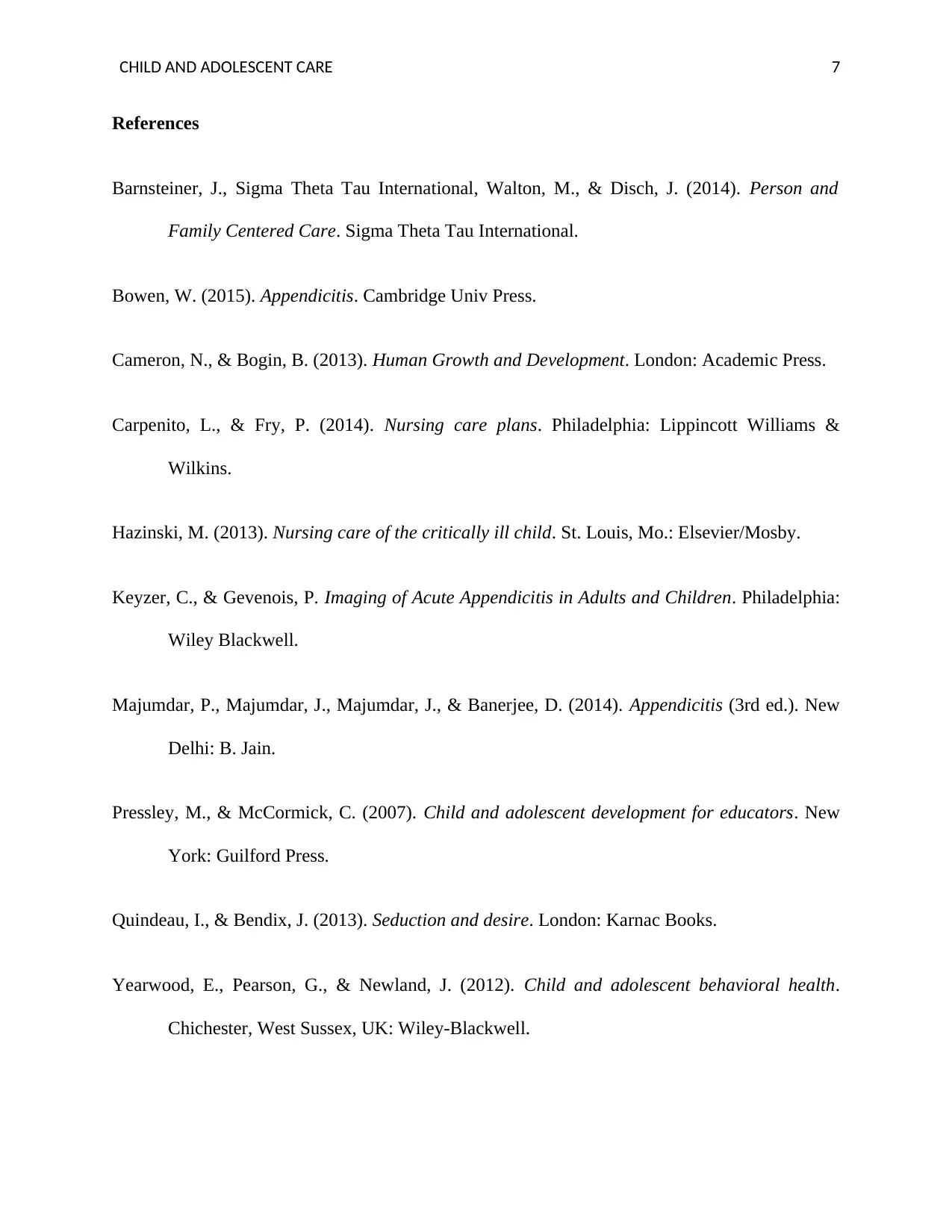
CHILD AND ADOLESCENT CARE 7
References
Barnsteiner, J., Sigma Theta Tau International, Walton, M., & Disch, J. (2014). Person and
Family Centered Care. Sigma Theta Tau International.
Bowen, W. (2015). Appendicitis. Cambridge Univ Press.
Cameron, N., & Bogin, B. (2013). Human Growth and Development. London: Academic Press.
Carpenito, L., & Fry, P. (2014). Nursing care plans. Philadelphia: Lippincott Williams &
Wilkins.
Hazinski, M. (2013). Nursing care of the critically ill child. St. Louis, Mo.: Elsevier/Mosby.
Keyzer, C., & Gevenois, P. Imaging of Acute Appendicitis in Adults and Children. Philadelphia:
Wiley Blackwell.
Majumdar, P., Majumdar, J., Majumdar, J., & Banerjee, D. (2014). Appendicitis (3rd ed.). New
Delhi: B. Jain.
Pressley, M., & McCormick, C. (2007). Child and adolescent development for educators. New
York: Guilford Press.
Quindeau, I., & Bendix, J. (2013). Seduction and desire. London: Karnac Books.
Yearwood, E., Pearson, G., & Newland, J. (2012). Child and adolescent behavioral health.
Chichester, West Sussex, UK: Wiley-Blackwell.
References
Barnsteiner, J., Sigma Theta Tau International, Walton, M., & Disch, J. (2014). Person and
Family Centered Care. Sigma Theta Tau International.
Bowen, W. (2015). Appendicitis. Cambridge Univ Press.
Cameron, N., & Bogin, B. (2013). Human Growth and Development. London: Academic Press.
Carpenito, L., & Fry, P. (2014). Nursing care plans. Philadelphia: Lippincott Williams &
Wilkins.
Hazinski, M. (2013). Nursing care of the critically ill child. St. Louis, Mo.: Elsevier/Mosby.
Keyzer, C., & Gevenois, P. Imaging of Acute Appendicitis in Adults and Children. Philadelphia:
Wiley Blackwell.
Majumdar, P., Majumdar, J., Majumdar, J., & Banerjee, D. (2014). Appendicitis (3rd ed.). New
Delhi: B. Jain.
Pressley, M., & McCormick, C. (2007). Child and adolescent development for educators. New
York: Guilford Press.
Quindeau, I., & Bendix, J. (2013). Seduction and desire. London: Karnac Books.
Yearwood, E., Pearson, G., & Newland, J. (2012). Child and adolescent behavioral health.
Chichester, West Sussex, UK: Wiley-Blackwell.
1 out of 7
Your All-in-One AI-Powered Toolkit for Academic Success.
+13062052269
info@desklib.com
Available 24*7 on WhatsApp / Email
![[object Object]](/_next/static/media/star-bottom.7253800d.svg)
Unlock your academic potential
Copyright © 2020–2025 A2Z Services. All Rights Reserved. Developed and managed by ZUCOL.